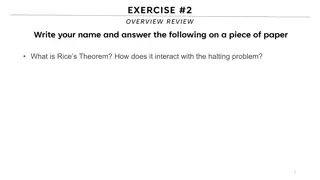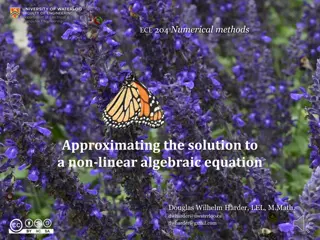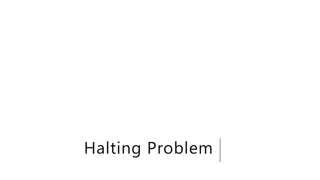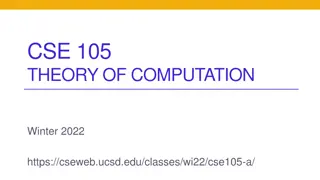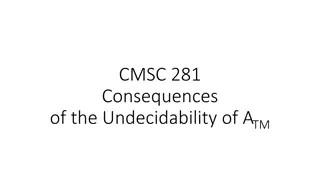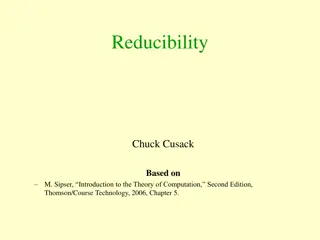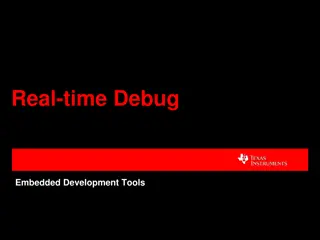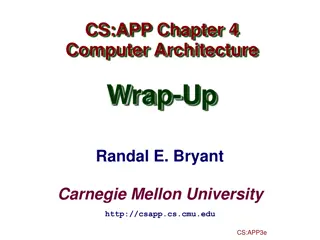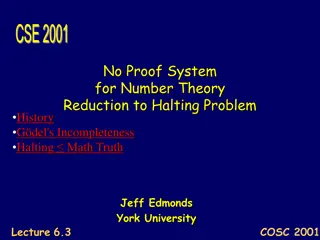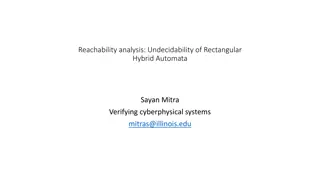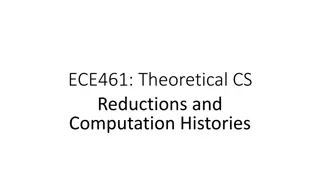Understanding the Halting Problem in CS Theory
Delve into the intricacies of the Halting Problem and its undecidability in computer science theory. Learn about the concepts of decidable and undecidable languages, the implications of the Halting Problem on computing, and explore the proof that demonstrates the undecidability of HALT.
Download Presentation

Please find below an Image/Link to download the presentation.
The content on the website is provided AS IS for your information and personal use only. It may not be sold, licensed, or shared on other websites without obtaining consent from the author. Download presentation by click this link. If you encounter any issues during the download, it is possible that the publisher has removed the file from their server.
E N D
Presentation Transcript
CS21 Decidability and Tractability Lecture 12 January 31, 2024
So far {anbn : n 0 } some language decidable all languages regular languages context free languages RE {anbncn : n 0 } This language might be an esoteric, artificially constructed one. Do we care? We will show a natural undecidable L next. January 31, 2024 CS21 Lecture 12 2
The Halting Problem Definition of the Halting Problem : HALT = { <M, x> : TM M halts on input x } HALT is recursively enumerable. proof? Is HALT decidable? January 31, 2024 CS21 Lecture 12 3
The Halting Problem Theorem: HALT is not decidable (undecidable). Proof: Suppose TM H decides HALT Define new TM H : on input <M> if H accepts <M, <M>> then loop if H rejects <M, <M>> then halt January 31, 2024 CS21 Lecture 12 4
The Halting Problem Proof: define new TM H : on input <M> if H accepts <M, <M>> then loop if H rejects <M, <M>> then halt consider H on input <H >: if it halts, then H rejects <H , <H >>, which implies it cannot halt if it loops, then H accepts <H , <H >> which implies it must halt contradiction. January 31, 2024 CS21 Lecture 12 5
The Halting Problem box (M, x): does M halt on x? inputs Y Turing Machines n Y The existence of H which tells us yes/no for each box allows us to construct a TM H that cannot be in the table. n n Y n n Y n Y Y n Y H : January 31, 2024 CS21 Lecture 12 6
So far {anbn : n 0 } some language decidable all languages regular languages context free languages RE HALT {anbncn : n 0 } Can we exhibit a natural language that is non-RE? January 31, 2024 CS21 Lecture 12 7
RE and co-RE The complement of a RE language is called a co-RE language some language {anbn : n 0 } co-RE decidable all languages regular languages context free languages RE {anbncn : n 0 } HALT January 31, 2024 CS21 Lecture 12 8
RE and co-RE Theorem: a language L is decidable if and only if L is RE and L is co-RE. Proof: ( ) we already know decidable implies RE if L is decidable, then complement of L is decidable by flipping accept/reject. so L is in co-RE. January 31, 2024 CS21 Lecture 12 9
RE and co-RE Theorem: a language L is decidable if and only if L is RE and L is co-RE. Proof: ( ) we have TM M that recognizes L, and TM M recognizes complement of L. on input x, simulate M, M in parallel if M accepts, accept; if M accepts, reject. January 31, 2024 CS21 Lecture 12 10
A natural non-RE language Theorem: the complement of HALT is not recursively enumerable. Proof: we know that HALT is RE suppose complement of HALT is RE then HALT is co-RE implies HALT is decidable. Contradiction. January 31, 2024 CS21 Lecture 12 11
Summary co-HALT some language {anbn : n 0 } co-RE decidable all languages regular languages context free languages RE {anbncn : n 0 } HALT Main point: some problems have no algorithms, HALT in particular. January 31, 2024 CS21 Lecture 12 12
Reductions Given a new problem NEW, want to determine if it is easy or hard right now, easy typically means decidable right now, hard typically means undecidable One option: prove from scratch that the problem is decidable, or prove from scratch that the problem is undecidable (dream up a diag. argument) January 31, 2024 CS21 Lecture 12 13
Reductions A better option: to prove NEW is decidable, show how to transform it into a known decidable problem OLD so that solution to OLD can be used to solve NEW. to prove NEW is undecidable, show how to transform a known undecidable problem OLD into NEW so that solution to NEW can be used to solve OLD. called a reduction January 31, 2024 CS21 Lecture 12 14
Reductions Reductions are one of the most important and widely used techniques in theoretical Computer Science. especially for proving problems hard often difficult to do from scratch sometimes not known how to do from scratch reductions allow proof by giving an algorithm to perform the transformation January 31, 2024 CS21 Lecture 12 15
Example reduction Try to prove undecidable: ATM = {<M, w> : M accepts input w} We know this language is undecidable: HALT = {<M, w> : M halts on input w} Idea: suppose ATM is decidable show that we can use ATM to decide HALT conclude HALT is decidable. Contradiction. reduction January 31, 2024 CS21 Lecture 12 16
Example reduction How could we use procedure that decides ATM to decide HALT? given input to HALT: <M, w> Some things we can do: check if <M, w> ATM construct another TM M and check if <M , w> ATM January 31, 2024 CS21 Lecture 12 17
Example reduction Deciding HALT using a procedure that decides ATM( reducing HALT to ATM ). on input <M, w> check if <M, w> ATM if yes, the M halts on w; ACCEPT if no, then M either rejects w or it loops on w construct M by swapping qaccept/qreject in M check if <M , w> ATM if yes, then M accepts w, so M rejects w; ACCEPT if no, then M neither accepts nor rejects w; REJECT January 31, 2024 CS21 Lecture 12 18
Example reduction Preceding reduction proved: Theorem: ATM is undecidable. Proof (recap): suppose ATM is decidable we showed how to use ATM to decide HALT conclude HALT is decidable. Contradiction. January 31, 2024 CS21 Lecture 12 19
Another example Try to prove undecidable: ETM = {<M> : L(M) = } which problem should we reduce from? HALT = {<M, w> : M halts on input w} ATM = {<M, w> : M accepts input w} Some things we can do: check if <M> ETM construct another TM M and check if <M > ETM January 31, 2024 CS21 Lecture 12 20
Another example We are given input <M, w> We want to use a procedure that decides ETM to decide if <M, w> ATM Idea: check if <M> ETM if not? helpful if could make M reject everything except possibly w. January 31, 2024 CS21 Lecture 12 21
Another example Is this OK? finite # of states? Construct TM M : on input x, if x w, then reject else simulate M on x, and accept if M does. on input <M, w> construct M from description of M check if M ETM if no, M must accept w; ACCEPT if yes, M cannot accept w; REJECT January 31, 2024 CS21 Lecture 12 22
Another example Preceding reduction proved: Theorem: ETM is undecidable. Proof (recap): suppose ETM is decidable we showed how to use ETM to decide ATM conclude ATM is decidable. Contradiction. January 31, 2024 CS21 Lecture 12 23
Example reduction We proved ATM = {<M, w> : M accepts input w} undecidable, by reduction from HALT = {<M, w> : M halts on input w} We proved ETM = {<M> : L(M) = } undecidable by reduction from ATM January 31, 2024 CS21 Lecture 12 24


